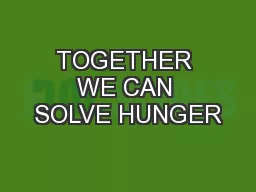

HUNGER IN AMERICA 2014 Background Methodology and Whats New Vermont Results Sharing Our Story Questions amp Discussion Agenda 1 Background amp methodology Hunger in America 2014 ID: 647311
Download Presentation The PPT/PDF document "TOGETHER WE CAN SOLVE HUNGER" is the property of its rightful owner. Permission is granted to download and print the materials on this web site for personal, non-commercial use only, and to display it on your personal computer provided you do not modify the materials and that you retain all copyright notices contained in the materials. By downloading content from our website, you accept the terms of this agreement.
Slide1
TOGETHER
WE CAN
SOLVE
HUNGER
HUNGER IN AMERICA 2014Slide2
Background, Methodology and
What’s New
Vermont Results
Sharing Our Story
Questions
& Discussion
AgendaSlide3
1
Background
& methodology
Hunger in America 2014Slide4
HUNGER IN AMERICA:
Methodology & What’s New
Primary
O
bjective: More precise client count estimates at the local level
2014: Collectively, the network visited twice as many programs for client data collection than in 2010
2014: The study’s scope was expanded to include all program types (e.g., senior centers, rehabilitation programs, mobile pantries, etc.)
This is the first time
Hunger in America
was offered in five languages.
2014: English, Spanish, Mandarin Chinese, Russian, Vietnamese
The study was administered electronically to increase accuracy and protect respondent privacy.
This is the first time
Hunger in America
has obtained data on
U.S. M
ilitary households, adult students, household medical conditions, and duplicated client counts.
Because of this dramatic change in scope and format,
Hunger in America 2014
cannot
be directly compared to previous studies. In framing our storylines for 2014, the National Office
will not
be making direct comparisons to the findings from 2010.Slide5
HUNGER IN AMERICA:
Methodology & What’s New
In HIA 2010:
In HIA 2014:
Result
Programs were categorized as
pantries, kitchens, and shelters
. Data was weighted using
these
3 categories.
Programs are categorized as meal and grocery. Data was weighted using these 2 categories.HIA 2014 included much broader and more diverse program types but data are not calculated the same.Client surveys were face-to-face interviews with volunteers.
Client surveys were
self-administered using touchscreen, private tablets.
The
ACASI tablet software is associated with greater respondent honesty;
clients may have responded differently
.
Client surveys were only collected at
pantries, kitchens, and shelters
.
Client surveys were collected at all eligible program types, including
senior meals, residential programs, and more
.
Client demographics may have shifted by
including previously-excluded populations
.Slide6
2
Vermont
ResultsSlide7Slide8
HUNGER IN AMERICA:
Who do we serve?
153,100
Individuals Annually
7.5%0-5
16.4%
6-17
59.4%
18-59
16.7%
60 +Slide9
HUNGER IN AMERICA:
Coping Strategies and Health
72%
PURCHASE INEXPENSIVE, UNHEALTHY FOOD
53%EAT FOOD PAST THE EXPIRATION DATE
53%
RECEIVE HELP FROM FRIENDS OR FAMILY
31%
WATER DOWN FOOD OR DRINKS
25%
SELL OR PAWN PERSONAL PROPERTY36%GROW FOOD IN A GARDEN23%OF HOUSEHOLDS HAVE A MEMBER WITH DIABETES46%OF HOUSEHOLDS HAVE A MEMBER WITH HIGH BLOOD PRESSURESlide10
HUNGER IN AMERICA:
Tough Choices
63%
58%
56%
52%
20%
HAD TO CHOOSE BETWEEN FOOD AND UNTILITIES
HAD TO CHOOSE BETWEEN FOOD AND TRANSPORTATION
HAD TO CHOOSE BETWEEN FOOD AND MEDICAL CARE
HAD TO CHOOSE BETWEEN FOOD AND HOUSEING
HAD TO CHOOSE BETWEEN FOOD AND EDUCATIONSlide11
HUNGER IN AMERICA
: Use
of Federal Nutrition Programs
66.4%
OF HOUSEHOLDS CURRENTLY RECEIVE 3SquaresVT78%OF HOUSEHOLDS PARTICIPATE IN THE NATIONAL SCHOOL
LUNCH PROGRAM
44%
OF HOUSEHOLDS PARTICIPATE IN
NATIONAL SCHOOL BREAKFAST PROGRAMSlide12
3
SHARING OUR STORYSlide13
Late last summer the Vermont Foodbank did a statewide press push to share data from the Hunger Study. NEW: County level reports available for 10 of 14 counties in Vermont.
NEW: Communication Toolkit Social InfographicsOp-edPress Release
HUNGER IN AMERICA:
Sharing Our StorySlide14
4
Questions & discussionSlide15
Judy Stermer – Director of Communications
jstermer@vtfoodbank.org
With questions or for more information, please contact:Slide16
together
we can
solve hunger.
TM